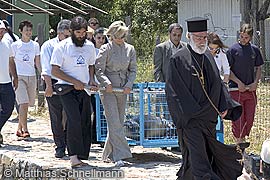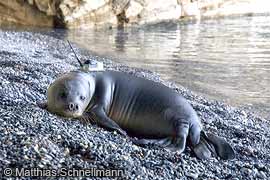

 |
||
 |
||
Vol. 7 (1): June 2004 |
Download this page
|
|
Greece / Israel / Madeira / Mauritania & Western Sahara / Turkey
Greece
|
|||||||||||||||||||||||||
 |
 |
|
|
Dimitris in his transport cage. |
Alonissos' priest leads the procession carrying Dimitris to the IFAW Odyssia. |
“I cannot get over how things have changed,” said an elated Eleni Tounta, MOm’s Head of Alonissos Programme. “When we released our first orphaned pups we were virtually on our own. Now many people seem to be with us.”
Dimitris was discovered following a violent December storm, stranded on a deserted beach on the eastern Aegean island of Karpathos [see Monk Seal Orphan Rescued on Karpathos]. The local fisherman who found the exhausted infant quickly raised the alarm – a testament, perhaps to changing attitudes in Greece, where fishermen have traditionally been hostile towards the species because of plummeting fish stocks and damaged nets. He spent the next 5 months in rehabilitation in MOm’s Intensive Care Unit, helped along the way by a host of institutional and individual supporters [see Monk Seal Pup on the Mend].
 |
|
|
Dimitris in December 2003, as an infant pup. |
In the complex rehabilitation procedure, MOm worked with the Seal Rehabilitation and Research Centre (SRRC) of the Netherlands, the Veterinary School of Thessaloniki and the Virology Department of Erasmus University, Rotterdam.
In its post-release satellite tracking programme, MOm is collaborating with the Sea Mammal Research Unit of St. Andrews University in Scotland, one of the world’s most experienced institutions in marine mammal satellite tracking.
Providing much-needed financial assistance was the Piraeus Bank of Greece; Princess Catherine Aga Khan; the Marchig Animal Welfare Trust; members and supporters of MOm and readers of The Monachus Guardian [see Big Day for Dimitris, the World’s Rarest Seal].
Once the pup was safely on board, the crew of the Odyssia wasted little time in casting off, and sailing out of Steni Valla’s little bay.
Two hours later, they arrived off the coast of Gioura, an uninhabited island in the heart of the Marine Park. Dimitris, still in his transport cage, was then carried ashore to the pre-selected release site, a shingle beach in an open cave. At first, he seemed reluctant to leave the security of his cage, but was eventually coaxed out onto the beach by his carers. After a 10 minute spell, sniffing the unfamiliar scents of the shingle, he fell asleep, and dozed for the next half hour.
Then, at 17.52, approximately one hour after his arrival, he wriggled his way into the calm sea, and within moments was rediscovering the underwater world that had been lost to him after that fateful December storm — chasing after fish, exploring the rocks where the Gioura cliffs plunge into the sea.
 |
 |
|
|
Dimitris finds home on Gioura in the National Marine Park of Alonissos, Northern Sporades |
||
After nightfall it was left up to a satellite several hundred kilometres above the Earth to track Dimitris’ movements.
In the first few days following his release, Dimitris mostly stayed close to Gioura’s shores, despite a brief one mile foray in an easterly direction towards the monk seal colony on the core zone island of Piperi. Lately, he has been more adventurous, exploring routes as far east as Aghios Efstratios.
Why all this fuss and effort for a single seal? Because Dimitris is a Mediterranean monk seal, Europe’s most endangered marine mammal and the world’s rarest seal species. Losing the fight for survival against forces ranging from industrial overfishing to uncontrolled mass tourism, the species is also a powerful ecological symbol of the threats facing the entire Mediterranean ecosystem. The fate of one is inextricably linked to the other, a fact that — thanks to Dimitris and others of his kind — politicians, industry and fishermen are increasingly beginning to realise.
Can you also help?
Consider making a secure online donation: Funds are still urgently required to cover the mounting costs of Dimitris’ rehabilitation, and post-release care. Your donation can be made via Kagi, the leading Internet service that ensures swift, secure online payments by credit card.
As the management authority of the National Marine Park of Alonissos-Northern Sporades gathered for its third meeting on the island on 3 June, members faced a demoralising agenda item: a complete absence of resources to undertake their government-mandated mission.
The authority held its inaugural meeting in August 2003, [see Management authority convenes on Alonissos, TMG 6 (2): December 2003], amid a renewed sense of optimism that the state was finally taking its conservation obligations seriously in Greece’s first National Marine Park.
Since then, however, a change in government in Athens, and a political agenda dominated by the summer Olympics, has seen the best intentioned plans for marine parks and protected areas in the country begin to unravel at the seams.
Despite pledges of the former PASOK government that funds would be transferred to the first 25 management bodies created for protected areas last summer, there is still no sign of the missing money. That has left Greece’s flagship Marine Park with no guards or patrol boats, no vehicles, no office, and no staff.
Some worry that, without government intervention, the NMPANS may be destined to follow in the notorious footsteps of the Marine Park of Zakinthos set up, amid international concern, to protect marine turtle nesting sites [see Challenge in the Ionian, TMG 5 (1): May 2002].
There, Greece’s first protected area management body has collapsed financially, and former employees – including guards – are in the courts, suing for non-payment of wages.
Another worry is that even previous government pledges lack a commitment to funding consistency – possibly because of a reliance on term-limited grants from the EU. Indeed, the previous government made it known that the NMPANS and the management authorities of other Greek protected areas would receive just 75% of their funding needs in the first year, 50% in the second, 25% in the third and thereafter, nothing at all. The implication was that the protected areas would then be left to their own devices to raise funds – a sink or swim privatization model that, despite certain merits, also holds considerable risk as management authorities debate the commercial exploitation of the areas under their control while fighting for their own survival.
While such issues remain to be clarified and resolved, the NMPANS is facing the summer tourist season with no guards or patrol boats. MOm, Greece’s leading monk seal NGO, and a member of the Park management authority, halted its own guarding efforts at the end of 2003 on the understanding that the authority would overtake responsibility for the programme. The organization even offered the use of its own patrol boat, ‘Alonnisos’, and its trained guards with 15 years’ experience, to facilitate the programme.
In its latest meeting, however, the management authority could only decide to request urgent funding support for the guarding operation from the Ministry of Environment. If the lesson of Zakinthos is anything to go by, however, they may be in for a long wait. – WMJ.
The islands at the end of the line, TMG 4 (2): November 2001.
All at sea – adrift in the Northern Sporades Marine Park, TMG 4 (2): November 2001.
MOm’s research team recorded 18 monk seal births during the 2003-2004 reproduction season in the organisation’s three main study areas.
Five newborn seals were recorded in the core zone of the National Marine Park of Alonissos-Northern Sporades, 8 in the Kimolos-Polyaigos area and 5 in the area of N. Karpathos-Saria. – Panos Dendrinos, MOm.
MOm has demanded that action be taken by the Port Police authorities to identify the killer of a seal, found dead on the island of Skopelos on 1 May 2004. Skopelos lies to the west of Alonissos, outside the Northern Sporades Marine Park.
The young male seal was found dead on Milies beach, 1-2 days after the killing.
The Port Police office in Glossa subsequently alerted MOm staff on Alonissos. A necropsy performed by MOm biologists revealed that the animal had been shot. A bullet, misshapen by striking the skull, was removed from the 3 cm head wound.
 |
 |
|
|
Dead on Milies beach. |
The bullet removed from the dead seal, misshapen by the force of entry, still shows the etched ‘G’ of its manufacture. |
Although direct killing by fishermen remains the primary cause of mortality for the species in Greece, such incidents have been virtually unheard of in the neighbouring NMPANS for a decade or more. Indeed, local fishermen on Alonissos were among the first to condemn the killing, and noted that prevailing currents appeared to make it unlikely that the seal had been shot in their fishing grounds.
In letters to the Port Police, MOm requested an investigation of the incident, and for measures to be taken to prevent any possible recurrence. Fishermen are not permitted to carry firearms aboard their vessels, although the law is often flouted.
 |
|
|
Relaxing on Patitiri beach. |
A male monk seal frequenting the southern coasts of Alonissos is displaying some uncharacteristic behaviour for a species whose temperament in recent history is most often described as shy, retiring and even monastic in nature. This particular individual has been hauling out onto beaches on Alonissos, in the Northern Sporades Marine Park, generating alerts to the local MOm office by baffled fishermen and startled tourists. Despite initial concerns last September when the seal was sighted occupying a small beach just outside the village of Votsi, the animal did not appear to be suffering from anything more acute than wounds to its rear flippers (a common injury among competing adult males). And since then, sighting the seal on an open beach has become an increasingly common occurrence. In early June, in fact, townsfolk of Alonissos’ main settlement, Patitiri, were amazed to find the seal asleep on the beach only a few metres away from shops, tavernas, and the busy hydrofoil port. – WMJ.
As part of MOm’s EU-funded LIFE-Nature project The Monk Seal: Conservation Actions in two Greek NATURA 2000 Sites, the following environmental education activities have been conducted on the islands of Kimolos and Karpathos:
– Stella Adamantopoulou, MOm.
EndQuoteMonk seals and Alonissos – A cool combination “The green Aegean oasis of Alonissos, part of the Sporades chain, is only one hour by hydrofoil from busy Skiathos. With just one public bus, no airport and four taxis, it might be the least-traveled island in the northern Aegean. By keeping tourism in check, the island has preserved much of its natural beauty. This is a haven of trails, delicate cliff-side chapels and the National Marine Park of Alonissos, established in 1992 to protect the endangered Mediterranean monk seal. Small sailboats, often with dolphins close by, cruise the uninhabited islets of the pristine sea park. Sailors drop anchor at nearby Peristera and spend an afternoon snorkeling over sunken ships or swim ashore and hike on trails dotted with juniper trees and wild orchids.”
|
Mediterranean News continues with Israel, Madeira, Mauritania & Western Sahara, and Turkey...
Copyright © 2004 The Monachus Guardian. All Rights Reserved |